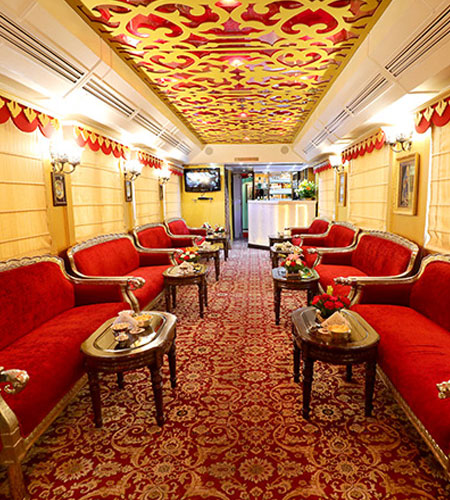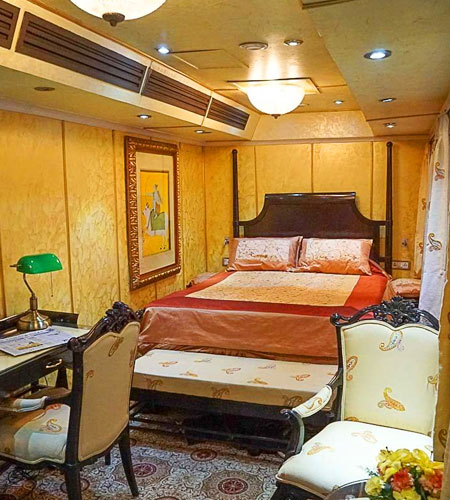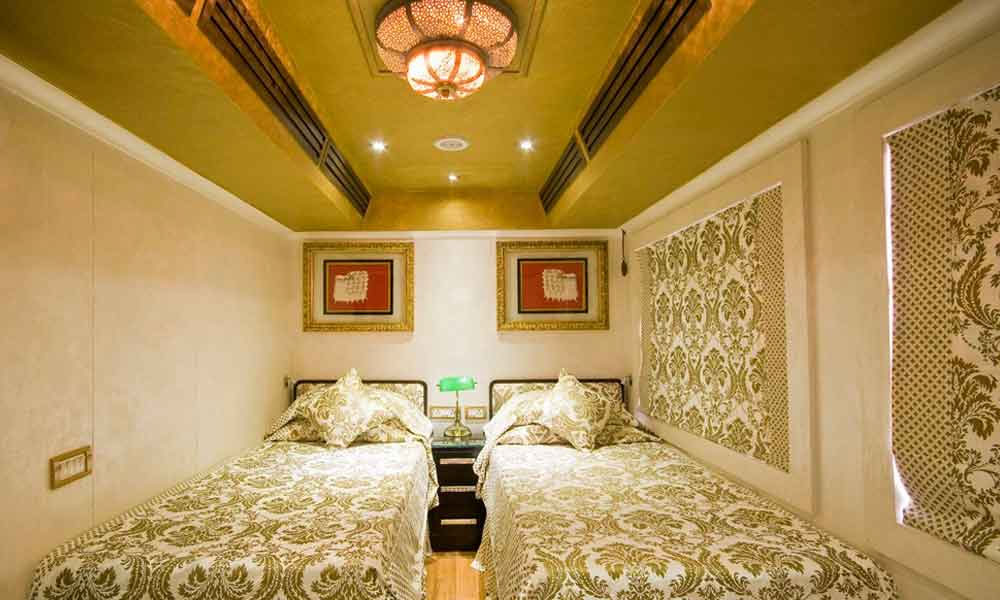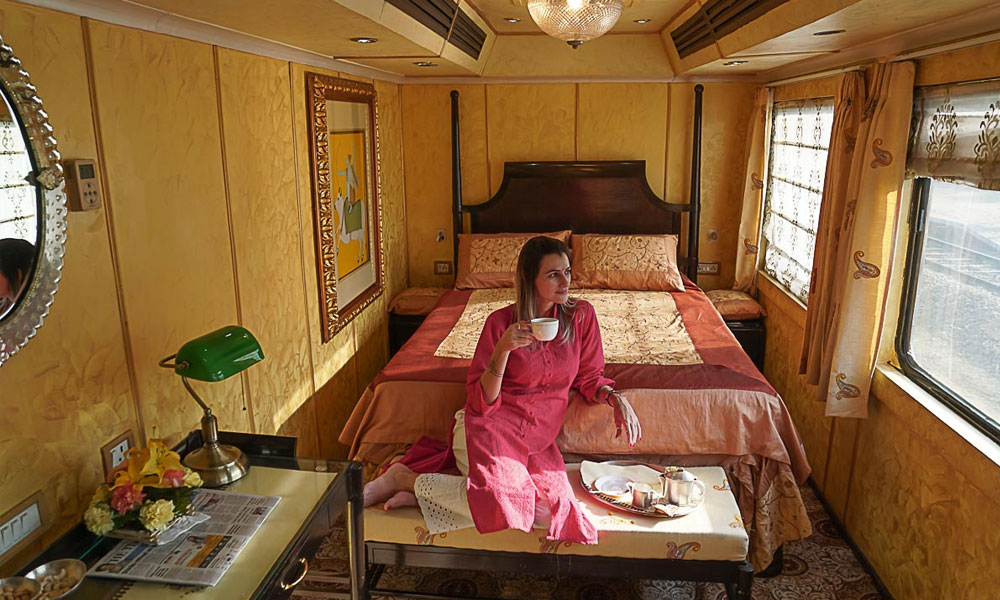About Palace on Wheels

Luxury Train
In a noble effort to boost tourism in Rajasthan, the Rajasthan Tourism Development Corporation and Indian Railways jointly inaugurated the Palace on Wheels, India’s first luxury train, on January 26, 1982. This regal Indian train comprises 14 guest coaches, each exuding a decorative style reminiscent of the personal carriages used by the Maharajas of yesteryears. Over the years, the train has undergone multiple refurbishments to incorporate technological advancements, ensuring an enhanced touring experience for guests. Furthermore, modern high-tech amenities have been seamlessly integrated, along with adjustments to the itinerary and off-train excursions.
The Palace on Wheels never fails to enchant guests with its warm hospitality and inviting ambiance. Its distinctive allure, elegance, and charm have earned it a well-deserved place among the world’s top five luxury trains. Pioneering the tradition of luxury train tours in India, this train has gracefully upheld the sophistication of Indian hospitality for over three decades.
Palace on Wheels Cabins:
The cabins of the Palace on Wheels exude a sense of royal opulence, mirroring the lavishness of the Indian luxury train itself. Consisting of 14 fully air-conditioned coaches, each cabin is a unique masterpiece, adorned with incomparable décor inspired by the once-reigning royal dynasties of Rajasthan, formerly known as Rajputana. Even their names pay homage to the distinguished provinces of the state.
Designed to accommodate royalty, these cabins not only boast stunning décor but also offer an array of luxurious amenities. Opulent silk fabrics, antique wooden furnishings, and exquisite artworks contribute to the grandeur. Moreover, your comfort is ensured with top-notch modern conveniences. Revel in the convenience of an en-suite bathroom stocked with plush toiletries, individual temperature control, seamless internet connectivity, electronic safety deposit box, telephone, and more. Additionally, each cabin is attended by a dedicated service professional, known as a Khidmatgar, to attend to your every need.
The cabins of the Palace on Wheels are divided into two categories – Deluxe Cabins and Super Deluxe Suites.

Luxurious Facilities on the Train
The Palace on Wheels offers top-tier amenities and well-appointed en-suite facilities. Each guest carriage is meticulously designed to replicate the opulence of original private salons once used by Maharajas, Nizams, and Viceroys of India. Guest cabins provide a serene, private sanctuary for reading, relaxation, or simply enjoying the passing scenery through panoramic windows.

Dining and Cuisine

Bar

Spa

Sitting Lounge

Luxury Room

About Coaches
The coaches of the Palace on Wheels are named after the former princely states of Rajputana. Each coach features four twin-bedded chambers adorned in authentic Rajasthani decor. Every guest cabin is furnished with amenities like channel music, running hot and cold water, a shower, attached toilets, intercom, and wall-to-wall carpeting to ensure a comfortable and lavish travel experience. Additionally, a personal attendant known as the ‘Khidmatgar’ is available in each saloon to attend to the guests’ needs around the clock.
The 14 Guest Coaches of the train embody the aesthetics and interiors of the princely states they are named after. Within each saloon, there is a mini pantry and a lounge equipped with a television, DVD player, and a small library. Guests are offered a selection of hot and cold beverages, along with refreshments, providing a space for them to gather, socialize, and unwind.
14 Names of Palace On Wheels Coaches
Alwar
Alwar, strategically positioned as the gateway from Delhi to Rajasthan, holds historical significance as a major hub for trade and commerce. The city boasts a diverse natural habitat with forests and deep valleys, providing refuge to various conserved and endangered species of flora and fauna. The Alwar Coach is adorned with a delightful mix of oils and cone work, featuring a lounge embellished with the royal emblem and a miniature painting. The subtle pink tones add to the romantic ambiance.
Bharatpur
Bharatpur, once the abode of the valiant Jat king Maharaja Suraj Mal, is now a paradise for ornithologists due to the Keoladeo Ghana Bird Sanctuary. The Bharatpur coach reflects this avian richness, depicting various bird species on the life tree. The coach follows a ‘nature’ theme with an aqua green and beige color scheme, reminiscent of the lush forests of Ghana and Bharatpur.
Bikaner
Founded in 1486 A.D., Bikaner came into existence with the establishment of a separate kingdom by Rao Bika. The Bikaner lounge draws inspiration from the opulent coronation rooms of the Padam Mahal and Anup Mahal in the Junagarh fort, featuring a color scheme of gold and burning red. The coach is adorned with the handicrafts of Rajasthan, including oil paintings on canvas and relief work on the ceiling. Notably, it showcases a canvas depicting the legendary lovers Dhola & Maru on camelback, influenced by the Mughal style and the Bikaner School of Art.
Bundi
The Bundi palace complex, situated above the township, is accessible through a paved ramp ascending towards the Hati Pol. This architectural marvel is beautifully depicted in watercolor work in one of the bedrooms featured in the Bundi Coach. The popular Rag Ragini or Ragmala oil paintings are also showcased, exuding the royal charm of a bygone era. The coaches’ decoration includes captivating frescoed ceilings that mesmerize onlookers.
Dholpur
Dholpur, known for its locally quarried sandstone, is a popular city where this material was used for lattice work in balcony railings and palaces. The Dholpur Coach features teak ply construction, showcasing fine craftsmanship akin to the sandstone work. The coach is adorned with intricate zardozi work, adding a regal touch.
Dungargarh
The unique architecture and the presence of Bhil tribals make Dungargarh a popular “hill town.” The coach’s ceilings are adorned with mirror and relief work, along with ‘lep’ work, emanating a royal feel. Intricate zardozi work further embellishes the coach.
Jaisalmer
Founded in 1156 A.D. by Rao Jaisal, Jaisalmer is known as the fort city. It boasts of havelis, cobbled streets, and ancient Jain temples that add to its regal charm. The coaches feature intricately carved jharokhas on the ceiling, inspired by the latticed havelis with beautiful facades. This exquisite work is showcased on teakwood, enhanced by mirror backing. The color scheme of the coach is a reflective beige, reminiscent of the desert sands.
Jaipur
Maharaja Swai Jai Singh established Jaipur, famously known as the Pink City, in 1727 A.D. He entrusted architect Vidhyadhar with the planning and design of the city. Jaipur is adorned with numerous palaces, monuments, and gardens, exuding an old-world charm that comes alive during the vibrant fairs and festivals. The ceiling of the Jaipur Coach is adorned with the renowned foil work or ‘Phad’, depicting festivals like Teej, Holi, Gangaur, Diwali, and more. The coach also features the state’s royal emblem in Zardozi work. Miniature paintings inspired by the popular Jaipur style grace the walls, while contemporary colors such as gold and blue enliven the frescoes on the ceiling.
Jhalawar
The powerful kingdom of the Jhalas, created in 1838 A.D., forms the foundation of Jhalawar’s historical significance. This land’s natural beauty and charm have endeared it to the erstwhile royals of Rajasthan. Noteworthy temples and Buddhist caves add to its allure. The Jhalawar’s ceiling is adorned in a style reminiscent of local homes, featuring a vibrant interplay of shades and mirror work on plaster of Paris, creating a distinctive ambiance. Additionally, Zardozi work is showcased alongside traditional handicrafts.
Jodhpur
The imposing Mehrangarh Fort dominates the city of Jodhpur, known for its cusped arcades and the elegant Moti Mahal, designed in the Mughal architectural style. The craftsmanship of the fort’s ceiling finds a counterpart in the Jodhpur Coach. Miniature paintings, reflecting the old-world charm and unblemished royalty, grace the interior.
Kishangarh
The ceilings of the Kishangarh Coach are adorned with the renowned Bani Thani paintings. These paintings captivate onlookers with their exquisite blend of colors and intricate designs. Notably, these paintings feature exaggerated depictions, such as oversized eyes and elongated fingers. Enamel and foil are used to create the ceiling artwork, and Zardozi work adorns the lounge walls.
Kota
Kota, a prosperous Rajput state, is nestled along the Chambal River, surrounded by lush green forests and scenic picnic gardens. Among its attractions, the City Palace stands out, featuring the vibrant Hati Pol entrance adorned with elephant figures. Inside the Kota Coach, oil paintings narrate the story of “Raja aur Praja” (The Monarch and his subjects), depicting Raja Ram Singh II (1826-66) of Kota in a royal procession on the coach’s ceiling.
Sirohi
The renowned Gold Fort has made Sirohi a globally recognized city. The fort’s standout feature is its colored glasswork, designed in the Indo-European architectural style. The rooms of the Sirohi Coach replicate this exquisite work, preserving the old-world charm through the coach’s setting and color scheme. The coach is adorned with gold foil, glasswork, and semi-precious stones embedded in its decor. Additionally, mounted miniatures grace the coach’s interior.
Udaipur
Once the capital of the Sisodia Rajputs, Udaipur sits gracefully on the edge of Lake Pichhola. The Udaipur Coach draws inspiration from the city’s palaces, adopting a blue and white color scheme. The lounge decor takes cues from the ‘Mor Chowk’ or Peacock Court. Intricate Patra or oxidized white metalwork and relief artistry adorn the coach, complemented by Zardozi work for an opulent finish.


